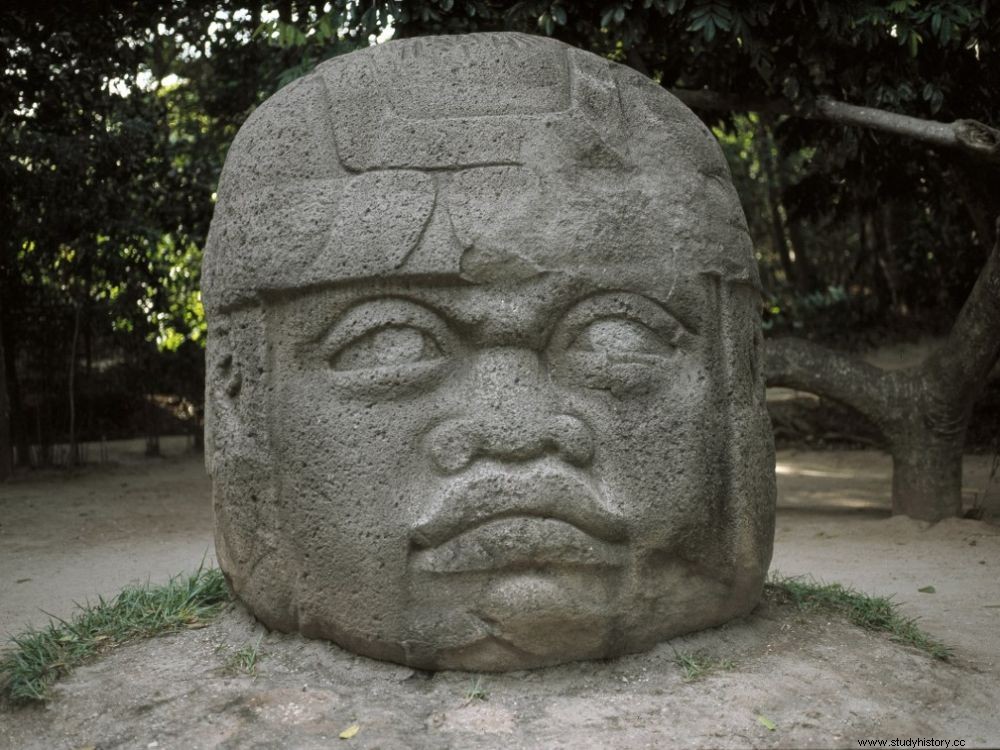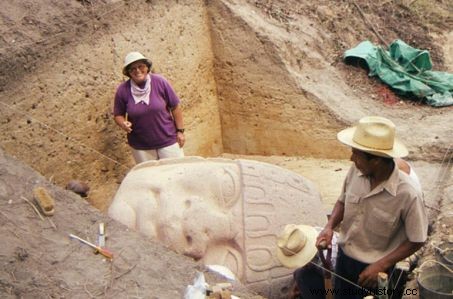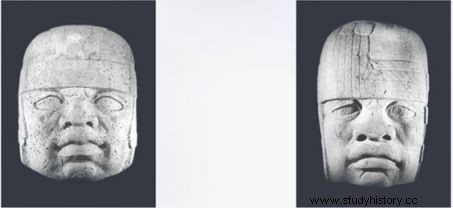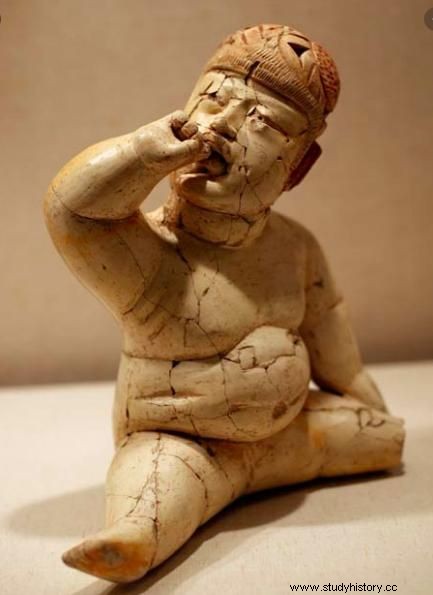These ancient inhabitants of Mexico carved strange giant heads whose significance we are only just beginning to understand. The archaeologist Ann Cyphers is preparing to publish a sum on this people whose Mayas and Aztecs are the heirs.

Pre-Columbian art from the Olmec civilization:this colossal stone head dates between the 13th and 10th centuries BC
Summary-
1
-
2
This article is from Sciences et Avenir magazine n°880 dated June 2020, "Covid-19:what we are sure of and what we have yet to discover ".
Cyclopean head in basalt or baby faces - figurines of adults looking like chubby children - these creations of the Olmec civilization are recognizable among all. They have captivated scholars who have sought to understand their meaning for decades. A world reference on this society which reigned over the Gulf of Mexico from the 13th to the 15th century BC, the American Ann Cyphers has dedicated her life to them. Crowned in December 2019 by the prestigious research prize of the 4th Forum of Archeology in Shanghai (China), the archaeologist from the National Autonomous University of Mexico (Unam), is preparing to publish the sum of her discoveries. Works that have renewed the approach of this society, considered the "mother" of all Mesoamerican civilizations, and whose heirs were the Mayas and the Aztecs. Reigning over the thick forests of the southern coast of the Gulf of Mexico, the Olmecs extended their territory to the northwest of Costa Rica and reached a very high level of development. The name they gave themselves not having come down to us, they were nicknamed Olmeca, the "people of the country of rubber" in the Nahuatl language, a name reinforced by the discovery, in the 20th century, of rubber balls in the sites where they had lived. Evidence that these people had long used the sticky, milky sap of the Castilla elastica tree .
Phoenicians, Africans and even extraterrestrials...
But the Olmecs are best known for fashioning gigantic heads from multi-ton monoliths, which "are neither extraterrestrial nor African in origin!" , hastens to clarify Ann Cyphers. Because since their exhumation, a tenacious myth surrounds these strange faces, born from the comments of a Mexican antique dealer, José Maria Melgar y Serrano, who had been able to observe the first unearthed in 1862 by a peasant in Veracruz. "He had found a little 'Ethiopian' air to it" , explains the archaeologist who recalls that no scientist at the time considered the existence of advanced societies in America. Since Bonaparte's campaigns in Egypt and the discovery of Nineveh in Iraq, all attention had indeed been turned to the Middle East. "The presence of Phoenicians or Africans in America was then a popular theory" , continues Ann Cyphers. "It was a way of denying the American populations the ability to be at the origin of powerful civilizations, says Caterina Magni, a specialist in the Olmecs. However, no relationship has ever been established between the African continent and Mesoamerica." What genetics has recently confirmed, adds anthropologist Enrique Villamar Bercerit, from Unam:"A pioneering study of mitochondrial DNA taken from human remains has concluded the indisputable American origin of the Olmecs. This people shared the most frequent of the five mitochondrial groups characteristic of indigenous populations on the continent. "
This article is from the magazine Sciences et Avenir n°880 dated June 2020, "Covid-19:what we are sure of and what we have yet to discover ".
Cyclopean head in basalt or baby faces - figurines of adults looking like chubby children - these creations of the Olmec civilization are recognizable among all. They have captivated scholars who have sought to understand their meaning for decades. World reference on this society which reigned over the Gulf of Mexico from the 13 e at 15 th century before our era, the American Ann Cyphers dedicated her life to them. Crowned in December 2019 with the prestigious 4 e research prize Shanghai Archeology Forum (China), the archaeologist from the National Autonomous University of Mexico (Unam), is preparing to publish the sum of his discoveries. Works that have renewed the approach of this society, considered the "mother" of all Mesoamerican civilizations, and whose heirs were the Mayas as much as the Aztecs. Reigning over the thick forests of the southern coast of the Gulf of Mexico, the Olmecs extended their territory to the northwest of Costa Rica and reached a very high level of development. The name they gave themselves not having reached us, they were nicknamed Olmeca, the "people of the country of rubber" in the Nahuatl language. , an appellation confirmed by the discovery, in the 20 e century, of rubber bullets in the sites where they had lived. Evidence that these people had long used the sticky, milky sap of the Castilla elastica tree .
Phoenicians, Africans and even extraterrestrials…
But the Olmecs are best known for fashioning gigantic heads from multi-ton monoliths, which "are neither extraterrestrial nor African in origin!" , hastens to clarify Ann Cyphers. Because since their exhumation, a tenacious myth surrounds these strange faces, born from the comments of a Mexican antique dealer, José Maria Melgar y Serrano, who had been able to observe the first unearthed in 1862 by a peasant in Veracruz. "He had found a little 'Ethiopian' air to it" , explains the archaeologist who recalls that no scientist at the time considered the existence of advanced societies in America. Since Bonaparte's campaigns in Egypt and the discovery of Nineveh in Iraq, all attention had indeed been turned to the Middle East. "The presence of Phoenicians or Africans in America was then a popular theory" , continues Ann Cyphers. "It was a way of denying the American populations the ability to be at the origin of powerful civilizations, says Caterina Magni, a specialist in the Olmecs. But no relationship was ever established in ancient times between the African continent and Mesoamerica." What genetics has recently confirmed, adds anthropologist Enrique Villamar Bercerit, from Unam:"A pioneering study of mitochondrial DNA taken from human remains has concluded the indisputable American origin of the Olmecs. This people shared the most frequent of the five mitochondrial groups characteristic of indigenous populations on the continent. "

American archaeologist Ann Cyphers unearthing the tenth of 17 colossal Olmec heads discovered to date. Credits:The San Lorenzo Tenochtitlan Project
"The Cyclopean heads are portraits of rulers, all different from each other" , continues Ann Cyphers. While directing the excavations of San Lorenzo-Tenochtitlan, a site considered the cradle of the Olmec culture, the American archaeologist herself unearthed the 10
th
of the 17 heads discovered to date (read the box above) . On the spot, thrones cut in the rock were also found, the whole forming a kind of royal alley arranged in two lines oriented north-south. "When I began my work in the 1970s, San Lorenzo was considered a town of 50 hectares, where less than 5,000 people lived. However, it now appears that it covered 800 hectares occupied by 11,000 inhabitants" , explains the archaeologist who deciphered the organization of the site:"San Lorenzo was the place of residence of the elite, while the rest of the population lived in small agricultural hamlets on the outskirts." She also retraced its chronology:around 1500-1200 BC, a primitive village took place on the plateau of San Lorenzo, then developed significantly around 1350-1250 BC. -form 1200 m long and 600 m wide was then built on a natural promontory. And it was around 1250-1150 BC, during the so-called Chicchara period, that the first monumental heads appeared. San Lorenzo reached its peak around 1150-900 BC before beginning to lose its influence around 700 BC

These faces carved in hard stone, would be giant portraits of dignitaries. Discovered in San Lorenzo-Tenochtitlan, Mexico, they were probably originally painted. Credits:Brizio Martinez
The Mystery of Big Heads
Of the 17 Olmec "colossal heads" identified to date in Mexico, ten have been discovered at San Lorenzo, four at the site of La Venta, two at Tres Zapotes and one at La Cobata. Possible fragments have also been found in Tlacozotitlan, in the state of Guerrero, as well as in Guatemala, in the region of Suchitepequez. The size of these monumental sculptures varies between 1.45 meters and 3.40 meters for a weight ranging from 8 tons to 50 tons! Traces of stucco and red paint were found on one of them, suggesting that most were painted. They were carved in hard stones (basalt and andesite), the extraction and transport of which was done by land or river from deposits located on the coast of the Gulf of Mexico.
But how to explain that these dignitaries are represented with the back of the flattened skull, almond eyes and flat nose? "Due to the anatomical deformities to which they were subjected , explains Ann Cyphers. This craniofacial modification was carried out from birth, when the bones are still malleable. This signified membership in the group." An explanation that does not exclude aesthetic research. "These heads express a style as it may have existed elsewhere in the world, in Egypt for example with the pharaoh Akhenaten who encouraged the art of Amarna also based on deformations" , adds the archaeologist.

The "baby faces", figurines representing adults looking like babies, are also part of the emblematic creations of the Olmec culture. Credits:AKG Images
The Olmec heritage spread to all subsequent Mesoamerican cultures. Identical deformities have thus been found in the Maya elite. But the Olmecs bequeathed much more. They are in fact the first in all of Mesoamerica to have established calendars or sacred architecture linked to its environment:the American archaeologist Robert Heizer (1915-1979) thus suggested that the Great Pyramid of La Venta, the most large Olmec ceremonial center, imitated a volcano in the Tuxtlas Mountains, visible from the site.
Oldest writing in America
The Olmecs are also at the origin of terraced dwellings, the development of platforms, the transport of water thanks to drainage systems, regional trade by river, while wide roads ensured exchanges at long distance. They also invented the oldest writing in America, with pictographs and glyphs attested on stelae as well as some colossal heads. Finally, they are at the beginning of the most spectacular of Mesoamerican ritual practices:human sacrifices that all subsequent cultures will take up.
Early followers of human sacrifice
The earliest evidence of human sacrifice in Mesoamerica has been found at San Lorenzo and El Manatí, two of the most important Olmec sites in Mexico, dated to 1200-1000 BC. The remains of six adult men were discovered there. They had been decapitated and dismembered before being buried as part of a consecration ritual. The skeleton of another adult man, also decapitated and cut up, was found under a ceremonial building. Children were not spared as evidenced by the bodies, dismembered during rituals in a sacred mountain sanctuary, exhumed in El Manatí. The Mayas and later the Aztecs will also practice these sacrifices in large numbers, perpetuating the distant legacy of the Olmecs.
